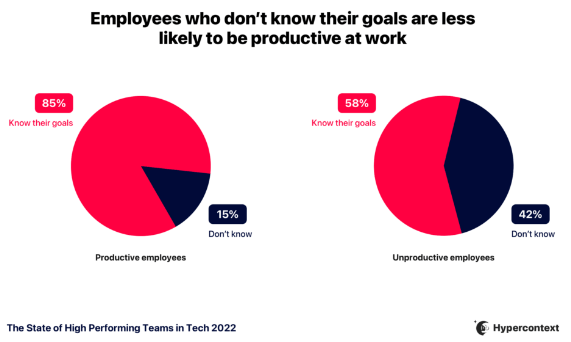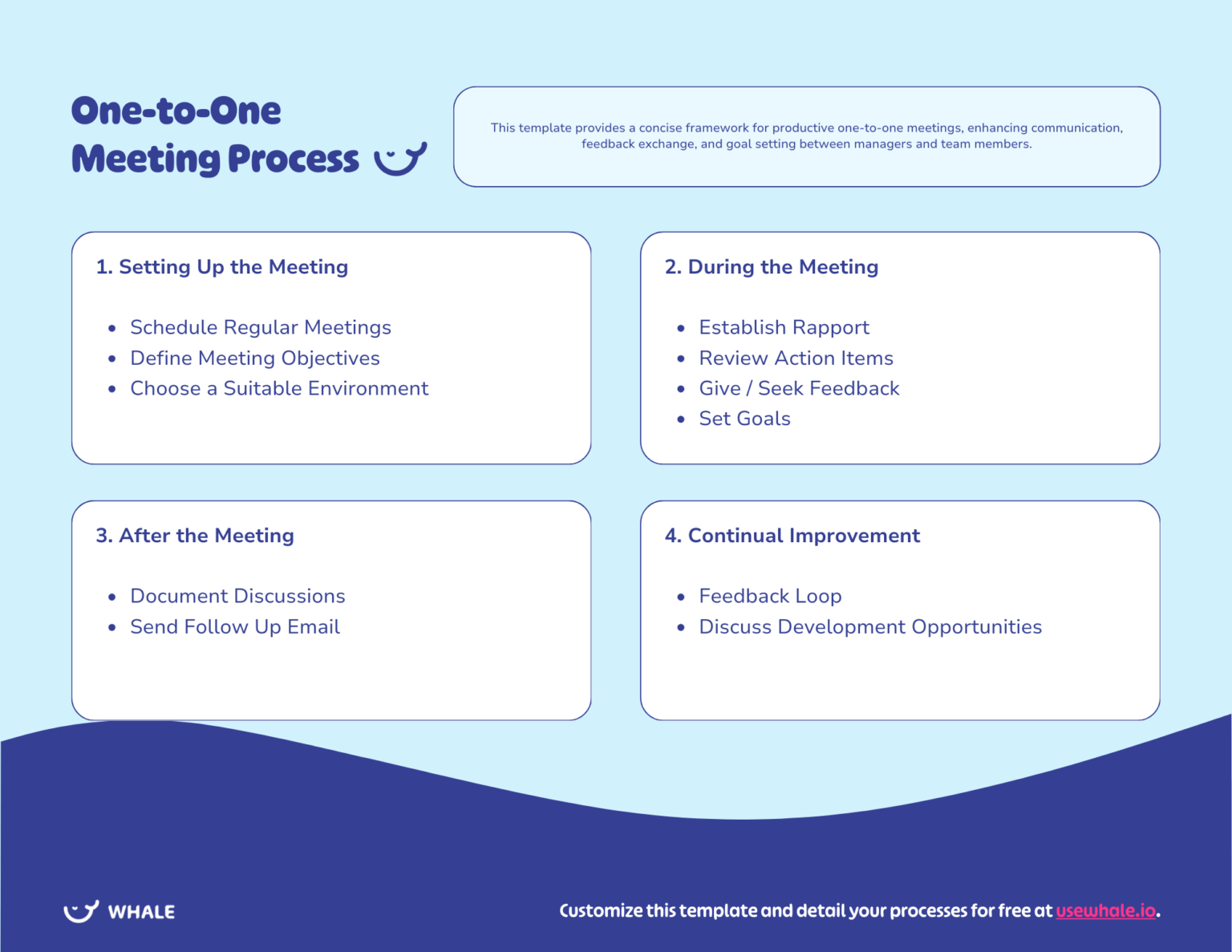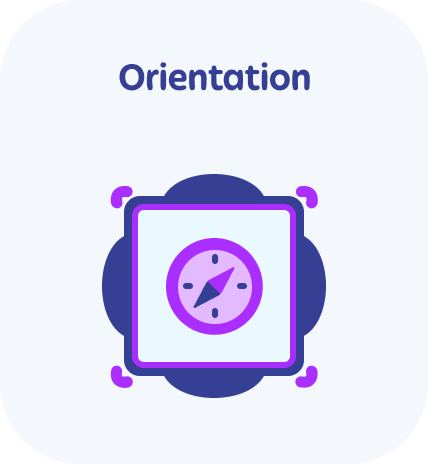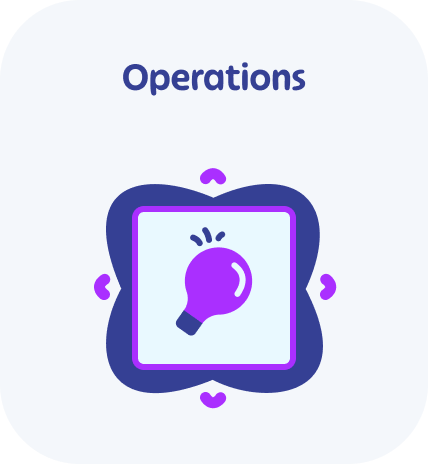We understand that your journey is unique and effective communication is key to unlocking your next level of growth. Whether you’re looking to boost productivity, foster a supportive work culture, or enhance employee engagement, one-on-one meetings are your secret weapon.
So, grab a cup of coffee, and let’s dive into creating meaningful and impactful one-on-one discussions that propel your business forward!
By adopting this One-on-One Meetings template, you are stepping towards a more engaged and motivated team. Remember, the goal is not just to communicate but to connect, inspire, and empower every individual in your organization.
Let’s make every conversation count!
What is a one-on-one meeting?
A one-on-one meeting is a dedicated session between two parties, typically a manager and an employee, aimed at fostering open communication, offering feedback, and discussing to-do lists, projects, performance and career development.
These meetings can supercharge performance and provide a private space for addressing workplace challenges, setting goals, and ensuring both parties are aligned with the company’s objectives.
Why do you need one-on-one meetings in your business?
One-on-ones keep your team members aligned and engaged.
If you’re serious about achieving your aims and objectives in your business, then you’re going to want to pay attention to getting your meetings on point.
To ensure meeting productivity, both managers and team members should prepare in advance, have specific objectives for each meeting, and maintain a follow-up system to track progress on discussed items.
Jeff Su on more productive one-on-one meetings.
Use our templates to fast-track your documentation
Customize this template and 100s of others for free in Whale, the fastest way to get your team aligned.
What are the benefits of a one-on-one meeting?
Every organization has goals and objectives and in order to achieve those goals and objectives, they need productive team members.
The fastest way to achieve that is to make sure that team members and managers are aligned and always working together.

The benefits of one-on-one meetings are manifold:
- Enhanced communication: These meetings foster an environment of open dialogue, helping to clear any misunderstandings and improve team cohesion.
- Increased engagement: Regular personalized interaction boosts morale and job satisfaction, leading to increased employee engagement.
- Direct feedback: They offer a platform for immediate and constructive feedback, facilitating personal and professional growth.
- Goal and team alignment: One-on-ones help in aligning individual goals with the company’s strategic direction, optimizing productivity.
According to a Gallup study, managers who receive regular feedback through one-on-one meetings see a 12.5% increase in productivity (Gallup, 2019).
Best practices for one-on-one meetings
To maximize the effectiveness of your one-on-one meetings, consider these best practices:
- Make time in your calendar: Consistency is key! Hold these meetings regularly to ensure continuous communication and relationship building. It may seem silly, but do it – block out a set time every week.
- Prepare an agenda: You’ll just see what arises. No, that’s not the way to attend a meeting. Come prepared with topics to discuss, but also be flexible to address emerging concerns.
- Listen actively: It’s often tempting to think of what you want to say while someone else is talking, but active listening is a skill that pays off. Listen to what the other person is saying before answering.
- Follow-up: Actions speak louder than words. Follow up on discussed items and commitments to build trust and accountability.
- Focus on the things that matter: This might seem like obvious advice but it’s important to focus the conversation on topics that are important.
Point to note:
When people talk about goals weekly or bi-weekly, they’re nearly 3X more likely to strongly agree that they’re confident about hitting their goals than those who talk about them quarterly. (State of High Performing Teams in Tech, 2022)
How often should you have a one-on-one?
The frequency of one-on-one meetings can vary based on the team’s needs and the nature of work, but the general rule of thumb is to ensure that managers have a weekly one-on-one where possible.
This is especially true when you have a new team member join the team.
You can always overbook and adjust. It’s better to start by over-communicating and getting feedback than letting things get out of hand.
Generally, it’s advisable to schedule them:
- Weekly for teams in dynamic environments where quick feedback and rapid decision-making are crucial.
- Monthly for discussions on long-term projects and strategies.
- Quarterly to evaluate performance and to review goals.
3 Types of one-on-one meetings
1. Weekly one-on-one
Weekly one-on-one meetings are ideal for ongoing project updates, addressing immediate issues, and coaching on short-term goals.
Note: For weekly team meetings at Whale, we use a Level 10 Meeting format.
2. Monthly one-on-one
Monthly one-on-one meetings are useful for reviewing monthly achievements, resetting goals, and discussing broader career aspirations.
3. Performance one-on-one
Typically conducted semi-annually or annually, performance one-on-one meetings focus on comprehensive performance reviews and career development planning.
Each type serves a unique purpose, tailored to different phases and needs within the business cycle.
Different roles in one-on-one meetings
One-on-one meetings are most effective when participants understand and actively engage in their roles. These meetings are a two-way street, with the manager and the employee having distinct responsibilities that complement each other.
In One-on-one Meetings, both roles need to collaborate effectively.
The role of the manager in one-on-one meetings
There are 3 main roles of a manager in creative, effective meetings that result in better team alignment, increased productivity, and enhanced employee engagement.
This involves;
- Creating psychological safety and an environment where team members can express their challenges
- Setting clear goals and expectations
- Asking the right questions – this is an entire topic and art on its own, but needless to say that, asking the right questions can unlock real engagement and take employee performance to new heights.
The role of the employee in one-on-one meetings
In a recent survey, Hypercontext asked direct reports what they found most challenging with one-on-ones. 34% stated that having meaningful, productive conversations was their biggest challenge.
So, how do employees take ownership and ensure that meetings are productive and useful? It comes down to ensuring that team members;
- Take ownership in setting the agenda
- Understand the expectations of managers
- Reframe meeting time as important and essential to productivity
- Give relevant and helpful feedback to managers
- Demonstrate next steps and action plans
FAQs on one-to-one meetings
How long should a one-on-one meeting last?
The ideal length for a one-on-one meeting is typically between 30 to 60 minutes.
This provides ample time to cover all topics without rushing, ensuring a thorough discussion while respecting both parties’ time.
What should be included in the agenda for a one-on-one meeting?
A well-structured agenda might include updates on ongoing projects, discussion of any challenges or roadblocks, feedback on recent work, setting goals for the next period, and a dedicated time for the employee to share their thoughts and concerns.
How do I handle sensitive topics during a one-on-one?
Approach sensitive topics with empathy and confidentiality.
Ensure the setting is private and that the conversation remains respectful. It’s important to be clear and direct while also being supportive and understanding. This remains true for both managers and team members.
Can one-on-one meetings be conducted virtually? What are the best practices?
Yes, one-on-one meetings can effectively be conducted virtually.
Best practices for virtual meetings include using a reliable video conferencing tool, ensuring good internet connectivity, being punctual, minimizing distractions, and maintaining eye contact as much as possible to foster a sense of connection.
How can I train my managers to conduct effective one-on-one meetings?
Provide training sessions that include role-playing scenarios, effective communication techniques, and feedback methods. Encourage managers to practice active listening, empathy, and agenda-setting to optimize their one-on-one interactions.
What if an employee is reluctant to speak up during one-on-ones?
Encourage open communication by asking open-ended questions, expressing genuine interest in their perspectives, and building trust over time.
It may also help to reassure them about the confidentiality and purpose of these meetings as safe spaces for honest dialogue.
Use our templates to fast-track your documentation
Customize this template and 100s of others for free in Whale, the fastest way to get your team aligned.







